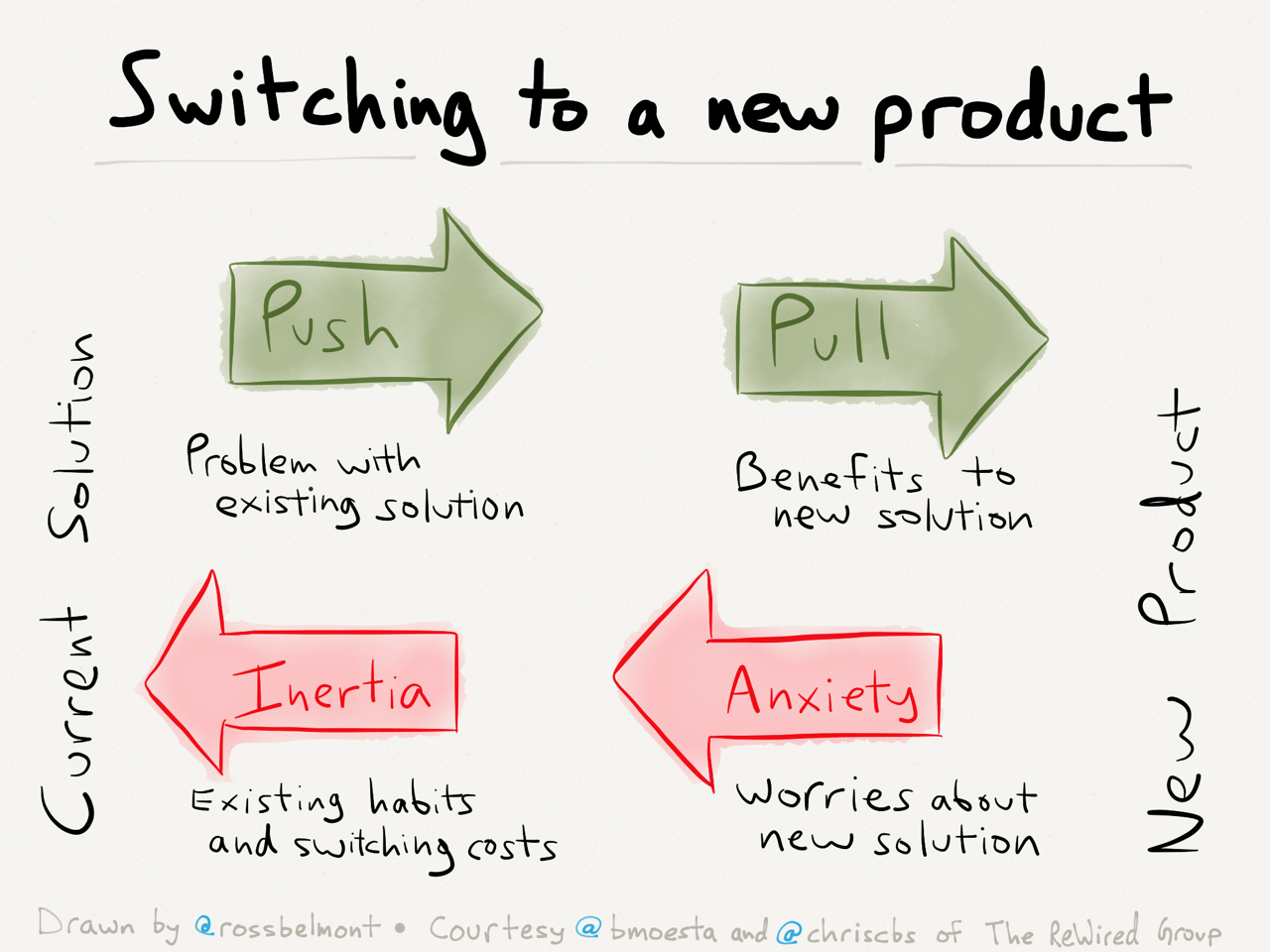Just as the diversity and breadth of digital products and services evolves, we recognize that our design methodology needs to keep pace.
To that end, we’ve been evaluating the Jobs to Be Done (#JTBD) theory that Clay Christianson authored, and that the good folks of the Re-Wired Group advocate. I recently attended one of their “Switch Workshops” hosted by Re-Wired’s Bob Moesta and Chris Speik.
“Switch” in this case refers to the moment an individual makes a decision to, in JTBD language, “hire” or “fire” a product or service. “Hiring” is akin to obtaining a thing for a specific purpose, while “firing” is, naturally, just the opposite. According to Bob, the switch moment is the most valuable, the most data-rich, because it’s where all the causality happens. This makes a ton of sense if you really want to know why someone buys a mattress, installs an app, or hires a contractor. It digs into the situational motivational forces that compel someone to act.

To uncover these forces, they use an interview format to reconstruct the events surrounding these trigger moments, with particular emphasis on leading events. There are a few requirements they use to qualify a valid switch:
- Past tense. The person needs to be looking in the rear view at a moment that’s come and gone. This differs from typical contextual field research which focuses on what’s driving a customer to buy in that moment, before they’ve actually purchased. Without a conclusive hire/fire decision, it’s impossible to know with certainty all that has and will contribute to a purchase decision.
- Broken in. They’ve got to have put the hired item through its paces enough to have come to an informed conclusion.
- 90 days. For all the nitty-gritties to remain top of mind and easily accessible, the switch moment needs to be recent, ideally within the last 3 months.
- No gifts. There’s too much indirection, bordering on hearsay, when it comes to the giving of gifts.
Bob and Chris set the stage for the workshop, explaining that they’d be live-demonstrating their technique by interviewing an attendee. They had everyone introduce themselves and share a qualifying product or service. When my turn arrived, I offered up a recent purchase of several Nest Protect smoke and CO2 detectors. After making it around the room, followed by a few tense minutes of heated deliberation (not really), I got the call.
I had listened to podcast versions of a few of these interviews and had a general sense of what to expect, but admit I was a bit nervous at the prospect of rehashing, in minute detail, to a group of 20 people and a microphone, all the thinking and actions that led me to spend $700 on high-end smoke detectors. Yikes - surely there was a less controversy-prone purchase I could have offered up.
A few key takeaways for conducting a worthwhile interview:
Focus on the Story, Not the Product
Don’t ask why someone bought a product. Don’t ask them to name its killer features. Do ask them to go back to the moment they realized the current product wasn’t cutting it. Do ask them who they were with in the store when they bought it, how that person reacted when they put it in the shopping cart. What was it like when they got home and opened the box? What time of day was it? Was it before or after work? Continue to root out juicy detail by asking probing questions that help rekindle those moments.
Follow Their lead
A good interview is one that unfolds organically, not tied to a static list of questions. The job of the interviewer is to actively observe: watching and listening for visual and verbal cues that signal leads worth pursuing.” OR “The job of the interviewer is to actively observe, watch and listen for visual and verbal cues that signal leads that are worth pursuing. In this regard, the interview is more art than science, and the interviewer needs to be able to adapt and change course with ease.
Keep an Ear Out for Motivational Forces
As the narrative unfolds in rich detail, or even if the momentum is waning a bit, remember you’re ultimately trying to discover what drove a person to switch. The Re-Wired team has come up with a model for mapping and quantifying the forces that produce switching moments. The model defines four forces that act upon an individual during the decision lifecycle:
- F1. Push. Problem with current solution
- F2. Pull. Benefits of a new solution
- F3. Anxiety. Worry about new solution
- F4. Inertia. Existing habits and switching costs<
Then you do the math:
(F1 + F2) < (F3 + F4) = No switch, current solution stays put.
(F1 + F2) > (F3 + F4) = Switch! Make way for the new solution.
Here is the a graphic forces diagram (courtesy of Ross Belmont):

As we continue to iterate and evaluate our design process, we’re actively adopting JTBD and participating in the Switch Workshop was an invaluable leveling up exercise to help speed along its adoption. And as far as my smoke detectors go, the family is sleeping much better these days…
To learn more, check out JTBD on Medium.

